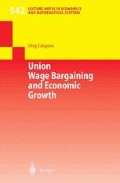Abstract
The main drawback of the models in the last sections is that although they deal with the long run impact of unions, they were not suitable for the analysis of the growth effects of union wage bargaining, because the rate of growth had been assumed exogenous or, even worse, there had been no growth at all.
Access this chapter
Tax calculation will be finalised at checkout
Purchases are for personal use only
Preview
Unable to display preview. Download preview PDF.
Author information
Authors and Affiliations
Rights and permissions
Copyright information
© 2004 Springer-Verlag Berlin Heidelberg
About this chapter
Cite this chapter
Lingens, J. (2004). Unions in an AK Model. In: Union Wage Bargaining and Economic Growth. Lecture Notes in Economics and Mathematical Systems, vol 542. Springer, Berlin, Heidelberg. https://doi.org/10.1007/978-3-642-17017-1_7
Download citation
DOI: https://doi.org/10.1007/978-3-642-17017-1_7
Publisher Name: Springer, Berlin, Heidelberg
Print ISBN: 978-3-540-21522-6
Online ISBN: 978-3-642-17017-1
eBook Packages: Springer Book Archive

